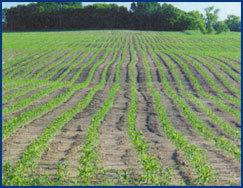
ON-THE-GO ADJUSTMENT OF SIDEDRESS RATES TO MEET A CROP'S PRECISE NITROGEN REQUIREMENTS IS COMING CLOSER TO REALITY
Light meter (CropScan) detects reflectance levels from the corn plants
The
holy grail of nitrogen management is an indicator that tells us exactly
how much nitrogen a corn plant needs for maximum economic yield. Leaf
color (more precisely, the amount of light reflected from leaves with
different shades of green) has potential as an indicator of nitrogen requirements.
And as a side benefit, this research confirms the value of applying some
nitrogen with the planter.

The amount of fertilizer nitrogen a crop requires is directly related
to total yield and the amount of nitrogen already available from soil
reserves. Predicting either of these factors is difficult, because weather
plays a significant role in eventual yields and in the amount of soil
nitrogen released, held or leached away.
Nitrogen recommendations have, for the most part, been based on the past
(previous nitrogen rate studies relative to yields obtained) or the future
(predicting your yield for that year). What growers need in an era of
high-cost nitrogen and environmental worries, however, is an accurate
indicator of exactly what their crops need on the day a sidedress application
is scheduled.
Real time or "in-crop" estimators of nitrogen requirements developed more
recently include leaf chlorophyll levels, plant tissue tests for nitrogen
concen-tration, and soil nitrate testing. Researchers have also been investigating
the concept that leaf color, or some sort of light reflectance measurement
based on leaf color, could indicate a corn crop's need for nitrogen.
Bill Deen and Jo-Anne Wakem at the University of Guelph's Department of
Plant Agriculture are exploring a method for using light reflection to
indicate nitrogen requirements. The unique aspect of this project is that
the researchers are attempting to drive the system through measurements
taken from corn plants in the 6- to 8-leaf stage. In this way, adjustments
to sidedress nitrogen rates could be made from the collected results.
The project involved a series of experimental sites where one row of the
corn planter delivered a significant amount of nitrogen (30 to 50 lb./ac.)
in a band close to the row while the other row received zero nitrogen
(top picture).The crop reflectance meter takes a measurement directly
over the top of the corn plants from each row (bottom picture ).
The aim of the research is to first define th differences in reflectance
between corn plants that have zero planting-time nitrogen, and those with
sufficient (30 lb./ac.) planting-time nitrogen. The second step is to
then demonstrate that this difference in reflectance will indicate the
soil's ability to supply nitrogen and hence give an indica-tion of how
much additional nitrogen should be sidedressed.
For example, if you planted corn into a field high in residual nitrogen
because of previous manure or legume crops, you might expect no difference
in green color between fertilized and unfertilized rows. That would be
a signal to apply little if any extra nitrogen.
If, however, unfertilized rows at the 8-leaf stage were considerably paler
than fertilized rows, the reflectance meter would measure that difference
and indicate the need for a higher rate of side-dressed nitrogen.
Differences in leaf color and reflectance between fertilized and unfertilized
rows were obvious at many of Deen's and Wakem's experimental sites last
year.
Their challenge is to calibrate reflectance scores against nitrogen requirements.
This requires more plot studies to determine optimum nitrogen rates, and
then
comparisons of those rates with the differences in reflectance.
The reality of mounting a light meter on the front of a tractor to assess
reflectance levels, send this information to an on-board computer, and
have the computer adjust the nitrogen application rate on-the-go is still
some distance off. But high nitrogen prices provide motivation to keep
investigating the potential of this science.
Some of last year's results reinforce the practical experience of more
and more corn growers who use sidedress nitrogen systems. That is, a significant
amount of nitrogen should be banded with the planter if the remaining
nitrogen is not going to be applied until sidedress time.
Over the 7 zones examined by Deen and Wakem in 2000, corn yields in rows
with zero nitrogen put down at planting averaged 9 bu./ac. less than in
rows that got about 30 lb./ac. at planting (Table 1 below). Coming in
at sidedress time with 200 lb./ac. of nitrogen couldn't make up the difference
even though 200 lb. was considerably more than the crop required.
| Table 1. More yield from planter-applied nitrogen | ||||
|
Field number |
0 lb./ac N at planting |
30 lb./ac. N at planting 1 |
Yield response to planter-applied N |
Maximum
economical |
|
------ corn yield bu./ac. -------- |
--- lb./ac. N --- |
|||
|
1 |
164 |
162 |
-2 |
162 |
|
2 |
145 |
169 |
24 |
158 |
|
3 |
142 |
154 |
12 |
114 |
|
4 |
126 |
136 |
10 |
96 |
|
5 |
118 |
127 |
9 |
99 |
|
6 |
140 |
140 |
0 |
120 |
|
7 |
133 |
144 |
11 |
135 |
|
Average |
147 |
138 |
9 |
126 |
| 1.
Actual N applied through the planter varied from 26 to 44 lb./ac. 2. Maximum economical nitrogen rate was determined from a series of multiple-N-rate plots Note: Both the 0 and 30 lb./ac N planting treatments received 200 lb./ac N at sidedress time |
||||